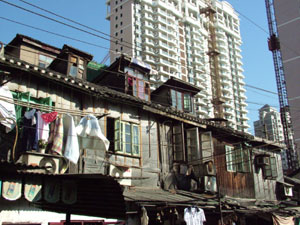Arno's EnergyIdeas (19)
Is China going green?
About the Olympic Games and renewable energies
China presented its nation and its people with a spectacular show at the opening ceremony of the 29th Olympic Summer Games in Beijing, a city with 15 million people. A good Opportunity, to show the world what is feasible with renewable energies today. China is always fascinated by the enormous diversity of this country, be it at a first visit or a longer stay there. The impressive multimedia show at the opening ceremony with 15 000 artists and 30 000 extra performers, by far more than just "small actors raised hope that the Chinese were going to make some "major" applications of renewable energies in the Olympics, but unfortunately this was not the case. A pity, really.

Photo: Arno A. Evers FAIR-PR, Starnberg |
In the German recent media services, you will not find much reflections about latest activities in China. However, it was only a few days ago, that the largest airport building in the world was inaugurated. In 2008, in Beijing alone, 50 new subway stations opened. Eyewitnesses in China report that they feel that most people in China are looking forward to the Olympics, they seem to be perfectly organized.
Chinese Official promised the Olympic Summer Games to be "Green Olympics".
However, the existing infrastructure in Beijing, including residential
buildings, Industry, vehicles, roads and expressways are, so far everything other than "real
Green".
In design and operation of the Olympic village and the Olympic venues (all
Olympic buildings cover a total area of nearly 2 million square meters),
the aspirations of a new China that is operated by renewable energies, is only partly visible.
Two small green examples: Before the start of the Games, a city network
of 200 bicycle rental stations with 50 000 bicycles is in operation. About
500 000 new trees were planted at the Olympic site.
The Chinese Suntech Power supplied the 130 kW solar system for the Olympic
Stadium, also known as the "bird's nest". In addition, the lanterns along the Olympic
Boulevard are lit by in building integrated photo voltaic systems (BIPV) with a
capacity of 66 MW. The 64.5 MW wind farm, producing electricity for the Olympic venues in Beijing
consists of 43 wind turbines (1.5 MW each) - designed and built by a Chinese
Company. The solar hot water system in the Olympic Village,
is intended for the supply of 12 000 athletes, coaches and officials.
Eighty to ninety percent of the street lamps in the vicinity of the
Olympic host sites are solar driven. Another system is a new solar technology, known as
Solar Wall Hybrid-PV/Thermal system for the simultaneous production of electricity
and heat.
A total of 500 "alternative energy vehicles, including 20 with hydrogen and
Fuel cells passenger cars are operating at the Olympic games. The cars, based on the VW Passat
GP, were produced in a cooperation of Shanghai Fuel Cell Vehicle Powertrain Co Ltd,
Tongji University and Shanghai Automotive Industry Corp.. These vehicles
were already on display at the booth of the Chinese Ministry of Science and Technology
(MOST) in 2004 at the Shanghai International Fair. The Tongji University
School of Automotive Engineering has been working since 2001 on hydrogen vehicles.
25-electric hybrid vehicles, based on the Chery A5 model, manufactured by
the Chinese Automobile manufacturer Chery Automobile Co., Ltd.. are used for passenger
transport. The first electric vehicle at an Olympic Games was actually a German
MBB (Messerschmitt-Bölkow-Blohm GmbH) -transporter car with
44kW Electric motor, as accompanying vehicle for the marathon run at the 1972 Olympics in Munich.
Three EvoBusse with Ballard fuel cells are since September 2005 in China. They
were also intended for the Olympic Games, ... however: The official website of EvoBus
contains no information about the current use of these vehicles.
The Olympic Summer Games 2008 in Beijing produce conflicting views. An
emerging country with almost unlimited opportunities for its people, whose
spontaneity, flexibility and friendliness always surprises. You can liturally feel
the Energy towards the constant changes in the country. It is exciting in any case,
this process to pursue.
Source: RenewableEnergyWorld.com
together with own research by Tobias Renz, Ulrich
Walter, Ulrich Felger and the author in China in the time frame 2002-2008.
Date: 12.08.2008 |
